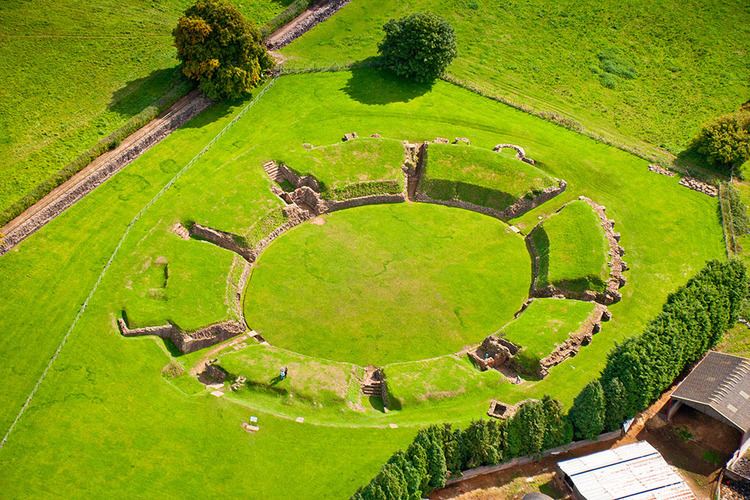Name Julius Aaron | ||
 | ||
Died c. 304 ADCaerleon, Britain, Roman Empire Honoured in Eastern Orthodox ChurchRoman Catholic ChurchAnglican Communion Feast 1 July (trad.)22 June (Cath.)20 June (Cath. & Ang.) | ||
Saints Aaron and Julius (or Julian) were two Celtic saints who are traditionally held to have been martyred at Caerleon, Wales, during the Diocletianic Persecution of Christians in 304. Along with Saints Alban and Amphibalus, they are the only named martyrs from Roman Britain. Their feast day was traditionally celebrated on 1 July, but it is now observed together with Saint Alban on 20 June by the Eastern Orthodox, Roman Catholic and Anglican Churches.
Contents
Medieval hagiography
By the High Middle Ages, their hagiography had been significantly elaborated. In his Description of Wales, Giraldus Cambrensis explains that Caerleon was native home of Amphibalus, a teacher to St. Alban. Other legends say that Julius and Aaron were Roman soldiers, and that after the martyrdom of Alban, Amphibalus returned to Caerleon, where he converted Julius and Aaron, among others, before their persecution and death in the Roman amphitheatre at Caerleon.
Aaron, with his Biblical name, was believed to be a Briton, and Julius, with his Roman name, was believed to be a Roman soldier.
Medieval cult sites
By the High Middle Ages, three churches dedicated to Julius and Aaron existed in Caerleon. The first was dedicated to Julius the Martyr and was graced with a choir of nuns. The second belonged to his associate Aaron and was ennobled with an order of canons. The third was the metropolitan of Wales, the seat of the Welsh bishop in ancient times.
The metropolitan see was relocated to Menevia (St Davids) by St. David, the patron saint of Wales, in 519. According to the 17th-century historian Francis Godwin, who wrote the "Early History of Religion" (De praesulibus Angliae) all three martyrs had a church named for them in the city of Caerleon. The chapels existed on the east and west sides of Caerleon, about two miles from each other. St. Julias' belonged to a nunnery and St. Aaron to a monastery of canons.
The churches are thought to have been damaged by storms and age, and they were finally fully destroyed under Henry VIII's dissolution of the monasteries, in the 1500s. The ruins of the monastic chapel of St. Julius were completely destroyed in the 15th century ", when Sir George Herbert built a manor with the name of "St Gillian’s", a corruption of "St Julian’s".
Location controversy
There is some evidence to suggest that the martyrdom may have occurred not in Caerleon but in Chester. When Gildas first mentions Julius and Aaron, he says that they were martyred in the "City of Legions", or legionum urbis. That could have referred to a number of legionary fortresses, including Chester and York, both of which carry the name in a number of sources. Archaeological excavations at an amphitheatre in Chester have uncovered a structure that may have been used for public executions in the Diocletian period and the possible remains of an early medieval church, which might be related to a Roman martyrdom site.
However, several other factors may point to the traditional association with Caerleon. An 8th-century grant found in the Book of Llandaff describes the boundaries of "territorium sanctorum martirium julii et aaron," or "the territory of the martyred saints Julius and Aaron", near Caerleon. Two 12th century charters reinforce the grant.
There is also evidence that Caerleon became a cult site for Julius and Aaron, which lasted to the High Middle Ages. The Book of Llandaff mentions a "Merthir Iun et Aaron, llor "sanctified cemetery of Julius and Aaron" at Caerleon. By 1200, there were at least three churches in Caerleon dedicated to them.
Modern
A Roman Catholic church dedicated to Aaron, Julius, and David was built in Caerleon at the end of the 19th century, as part of what is now the Roman Catholic Archdiocese of Cardiff. The Anglican parish church of St. Julius and St. Aaron was established in the St Julians suburb of Newport in 1924.
The 2004 edition of the Roman Martyrology recognizes the martyrs as being martyred after Alban during the persecution of Diocletian by the legionaries of Brittania Minor (Brittany), during which many 'arrived at the glorious city [of heaven] after enduring painful tortures and severe flogging'.
The Roman Martyrology indexes Aaron and Julius under 22 June, but since it is also the date when Saints John Fisher and Thomas More are celebrated, the current Roman Catholic liturgical calendar for Wales commemorates them together with St. Alban, on 20 June.
